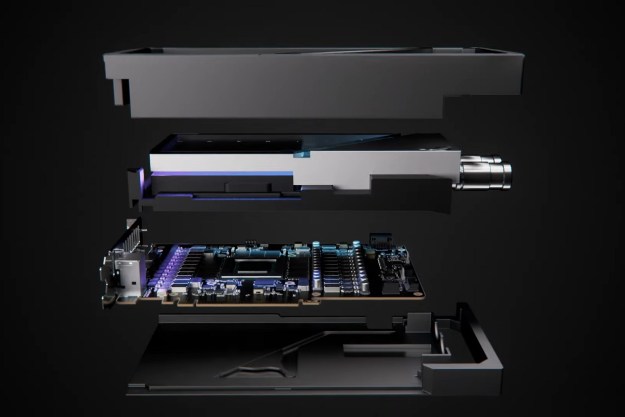With the release of the Radeon RX 7800 XT and RX 7700 XT, AMD finally set foot in the mainstream gaming sector with its RDNA 3 lineup. Nvidia, its biggest rival, which also makes some of the best graphics cards, was the first to release competing cards with similar performance — at least on paper. But are Nvidia’s options better than AMD’s in this generation?
The RX 7800 XT was, from the get-go, said to be the competitor to Nvidia’s RTX 4070, but in reality, these GPUs differ both in price and performance. We’ve tested the RX 7800 XT and compared it to the RTX 4070, and we now know which of these two GPUs is the one to pick.
Pricing and availability
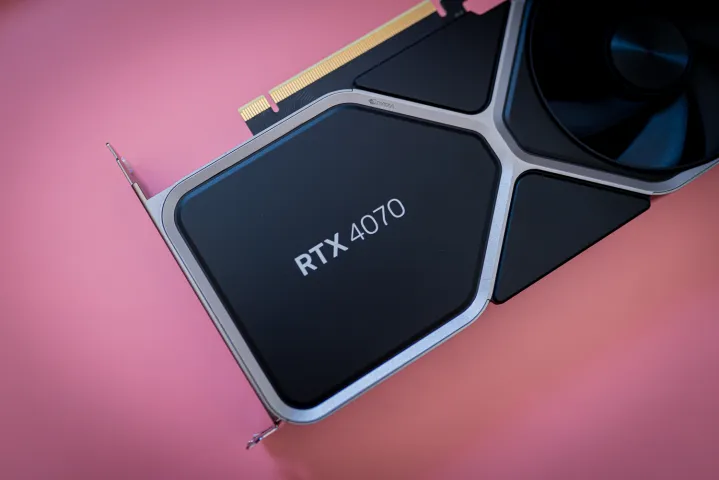
While the RX 7800 XT and the RTX 4070 came out a good few months apart, they were both highly anticipated releases that were much-needed in the GPU market. When the RTX 4070 launched, it was pretty much the only mainstream option in a market filled with high-end cards like the RTX 4090 or the RX 7900 XTX. The RX 7800 XT, on the other hand, finally bridges the gap in AMD’s lineup and presents an option to gamers who need a reasonably powerful PC build.
Nvidia’s card came first. The RTX 4070 launched on April 13, 2023, and was priced at $600. This felt reasonably competitive when compared to its older sibling, the RTX 4070 Ti ($800). Even months after launch, it’s hard to find an RTX 4070 for less than $600.
The RX 7800 XT launched on September 6, 2023, with a recommended list price (MSRP) of $500. Alongside the RX 7800 XT model, AMD also released the RX 7700 XT, priced at $450, which puts it in a less competitive position than the 7800 XT.
Specs
| RTX 4070 | RX 7800 XT | |
| Architecture | Ada Lovelace | RDNA 3 |
| Boost clock speed | 2.47GHz | 2.43GHz |
| VRAM | 12GB GDDR6X | 16GB GDDR6 |
| Bus width | 192-bit | 256-bit |
| TBP/TGP | 200 watts | 263W |
| Price | $600 | $500 |
When it comes to specifications, comparing AMD to Nvidia is always challenging, as there’s little overlap in specs. Each GPU has an entirely different architecture, and while they’re both built to do similar things, the ways in which they achieve them are vastly different. First, let’s take a look at the specs they do have in common.
The RTX 4070 has a marginally higher boost clock speed, but it also has a lot less memory (although it uses the more efficient GDDR6X instead of GDDR6). As VRAM has been a hot topic in games as of late, AMD decking out the RX 7800 XT with 16GB of memory is a smart move, although the memory speed on the 7800 XT is lower than on the RTX 4070 (19.5Gbps and 21Gbps, respectively). The 7800 XT also has a wider bus, but the price for these improvements is an increase in power consumption.
Then there are the specs that don’t really translate in a one-to-one comparison. For instance, Nvidia’s RTX 4070 sports 5,888 CUDA cores, whereas the RX 7800 XT uses Compute Units (CUs), and it only has 60 of them, which means 3,840 Stream Processors (SPs). Again, due to the totally different architecture of each GPU, these numbers don’t make much of a difference when you stack them up against each other — they just speak of each card’s individual compute power compared to the rest of its respective lineup.
The RTX 4070 also comes with 46 3rd-gen ray tracing cores and 184 4th-gen tensor cores. Meanwhile, AMD’s RX 7800 XT offers 60 ray tracing accelerators and 120 AI accelerators.
Overall, the cards are somewhat close in terms of specs. AMD packs more memory, but it’s slower, while the RTX 4070 has less VRAM, but it’s faster. Let’s see how that translates to performance.
Performance
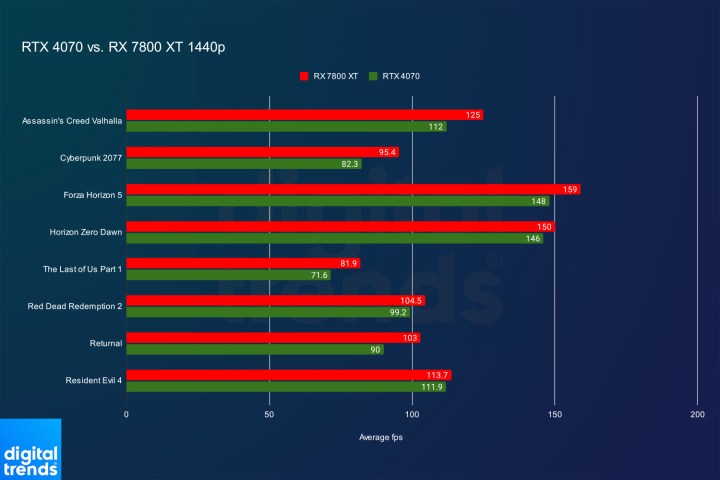
Specs can only get you so far — what truly matters is the way these GPUs perform, and as they’re consumer cards mainly made for gamers, the best way to measure their capabilities is to take them out for an extensive spin in some of the most demanding games. We’ve tested them both thoroughly, and we now know how they fared in various gaming scenarios.
While it’s worth noting that both the RX 7800 XT and the RTX 4070 are meant to be 1440p graphics cards, each shows some promise in 4K gaming, too. Still, let’s first compare them in their intended resolution.
We’ve tested the cards in eight different games, and in each benchmark at 1440p without ray tracing, the RX 7800 XT managed to claim victory in terms of frames per second (fps). The lead is not major in most titles, but in some games, such as Assassin’s Creed Valhalla and Forza Horizon, it shoots ahead. Across our entire test suite, the RX 7800 XT averaged 116.6 fps, while the RTX 4070 maxed out at 107.6, which makes the AMD card around 8.5% better at this resolution.

Introducing ray tracing into the mix shakes things up a little, as is to be expected. Historically, Nvidia has been the uncontested champion of ray tracing, and AMD only started to catch up in the last two generations. The benchmark scores show it, too; the RTX 4070 also beats the RX 7800 XT in Cyberpunk 2077 and in Metro Exodus. In the case of Cyberpunk, the 4070 takes the score into the low end of playable territory.
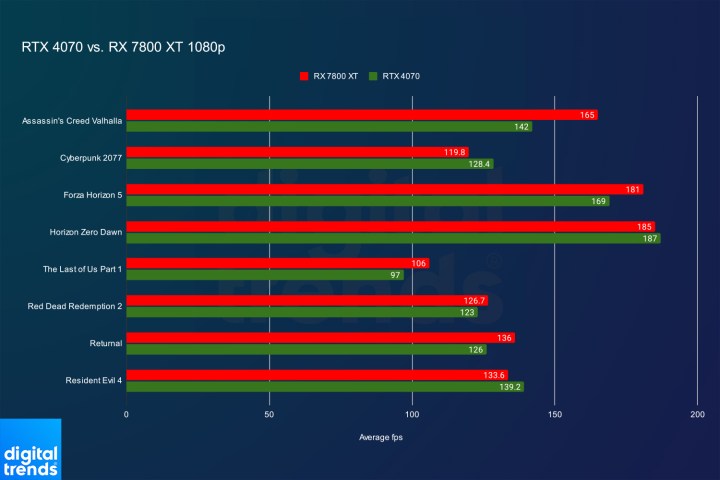
While these two GPUs are doing swell at 1440p, they’re great for 1080p purposes, too — although you could definitely get away with spending less. The benchmarks at 1080p without ray tracing further extend AMD’s dominance, giving it a commanding lead in most titles. However, Nvidia’s RTX 4070 actually fares better in Cyberpunk 2077 and Resident Evil 4. The scores in Horizon Zero Dawn are almost the same, but if you look across the suite, the RX 7800 XT is still faster in most games.
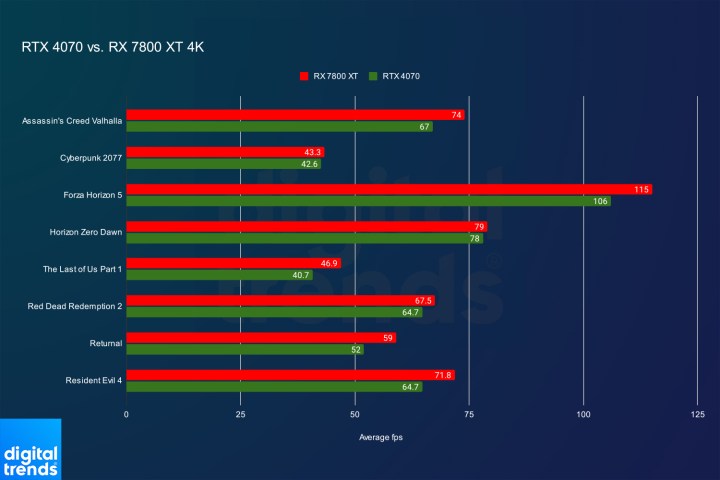
Moving up to 4K shows that the RX 7800 XT has more potential in that area than the RTX 4070. Sure, both GPUs keep it playable, but the RX 7800 XT maintains decent frames throughout our test suite, dipping down a little in demanding titles like Cyberpunk 2077 and The Last of Us Part 1. Overall, at 4K without ray tracing, the RX 7800 XT leads by 7.9%.
We have a winner

The benchmark results speak for themselves — AMD’s RX 7800 XT performs better in games at every resolution, all the while being $100 cheaper than Nvidia’s RTX 4070. It’s also more capable of handling 4K gaming, which makes it a slightly superior option if you’re in the market for a 4K monitor.
However, as always when comparing AMD to Nvidia, it’s not as simple as just adding up some fps figures and determining which card did better. The RTX 4070 appears to be slightly better at tackling ray tracing, which should come as no surprise. However, the gap isn’t as massive as one might have expected, and if you’re not big on ray tracing, you won’t even feel a difference. Ray tracing at 4K is not recommended with these GPUs anyway, and even at 1440p, there are titles (cough, Cyberpunk 2077) where it’s going to be a lag fest if you attempt to toggle it on.
Then there’s the question of upscaling tech, namely Nvidia’s coveted Deep Learning Super Sampling 3 (DLSS 3). This has been a major selling point for Nvidia in this generation, and it could potentially boost your frame rates well past the RTX 4080, and even the RTX 4090, if you turn it on. There’s a catch, though — not all games support it, and it might not even be as useful as Nvidia would have you believe. It’s still a selling point, but not one to base your entire buying decision around.
What’s the verdict? It all comes down to how much you care about Nvidia’s extra capabilities. If you don’t need insane levels of ray tracing support, and DLSS 3 is of no use to you, then the RX 7800 XT is an easy $500 choice. If you want DLSS 3 and don’t mind that the card will be a little slower across the board, then the RTX 4070 is the way to go. Keep in mind that means spending $100 more than the price of the RX 7800 XT, mainly to unlock DLSS 3.
Editors' Recommendations
- Nvidia RTX 50-series graphics cards: news, release date, price, and more
- This underrated AMD GPU beats the RTX 4070 Ti Super
- I tested AMD’s RX 7600 XT against the RTX 4060 — and I was shocked by the results
- RTX 4080 Super vs. RTX 4070 Ti Super vs. RTX 4070 Super: Nvidia’s new GPUs, compared
- AMD has another new GPU that it says can beat the RTX 4060 Ti




